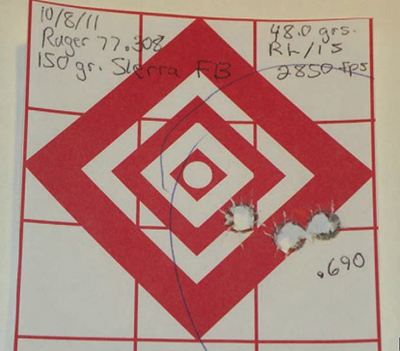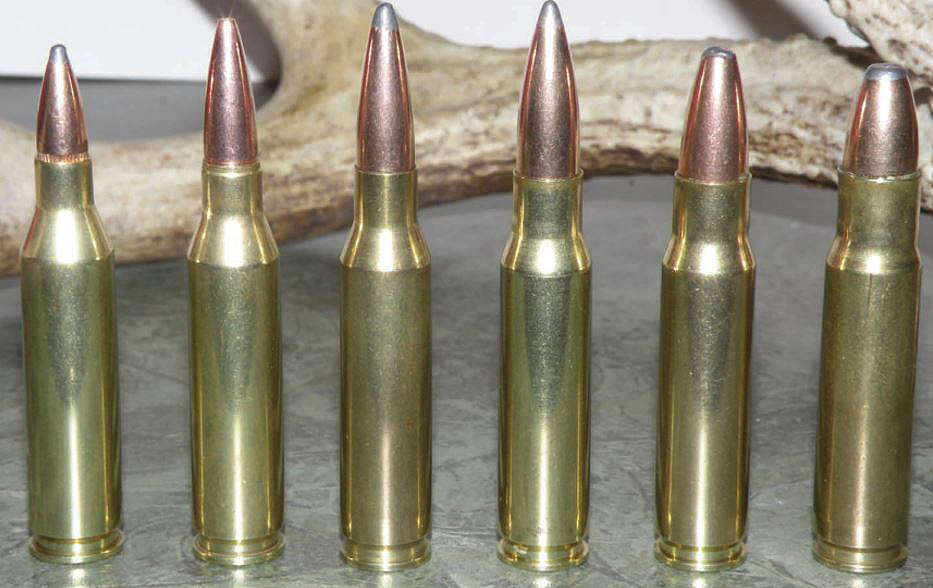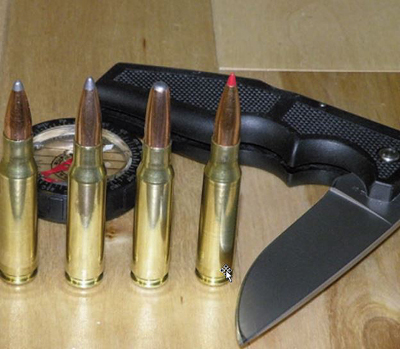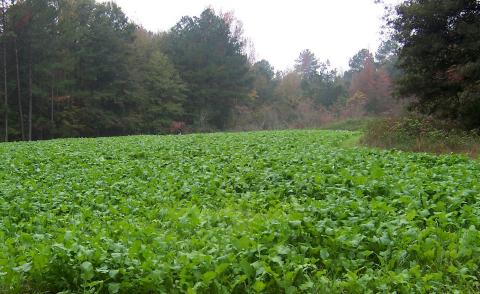Ken Delano | Originally published in GameKeepers: Farming for Wildlife Magazine
What is the .308 Winchester?

This group measuring less than 3/4" was fired from a Ruger 77.
I love the GameKeeper concept. I hear from those who receive the magazine that they like it because it gives them practical things they can do to better manage their land and the animals that inhabit it. It’s not just another magazine full of “dead deer pictures,” as one friend put it. That practical “nuts-and-bolts,” give-me-what-works philosophy makes the .308 Winchester an ideal cartridge for a GameKeeper.
Introduced as a commercial cartridge in 1952, two years before the military version 7.62 x 51mm was adopted as the standard battle rifle cartridge for NATO allied countries, the .308 was met with enthusiasm by the shooting public. Its short overall length (nominally 2.8”) has come to define the term “short-action,” and it has generated a whole family of highly useful cartridges for the hunter, including the .243 Winchester, .260 Remington, 7mm-08 Remington, .358 Winchester and most recently, the .338 Federal. All of these are simply the basic .308 case necked up or down to form the new cartridge.
Advantages of the .308
Advantages of the .308 Winchester are many. It combines adequate bullet diameter, weight, and velocity with manageable recoil in a rifle of compact size and moderate weight. It is available in every rifle action-type; bolt, lever, semi-auto, pump, and single-shot. Factory loadings are plentiful, generally of excellent quality, and are available world-wide. Accuracy is typically very good, and the .308’s trajectory is flat enough for most real-world use. For the reloader, the .308 offers good balance, a wide variety of useable powders, and .30 caliber bullet choices are as versatile and varied as they come.

The .308 made its reputation as a deadly-reliable medium game killer with bullet weights from 150 to 180 grains. The hunter armed with a .308 with quality optics and loaded with good factory ammo or hand-loads in the 150 – 180 grain range, is ready for any medium to large non-dangerous game in the world. Selection of bullet construction styles can further tailor the hunter’s ammo to the game pursued – a sleek, thin-jacketed 125 grain for predators, a rapidly expanding standard construction 150 grainer for lighter game such as whitetails or antelope, or a tougher controlled expansion 165 or 180 grain load for larger game like big mule deer, northern whitetails, elk, moose, or black bear.

the .308. L to R, 110 grain Hornady spire point, 150 grain
Sierra spitzer flatbase, 180 grain Speer round nose, and
180 grain Hornady Interbond.
There are too many factory ammo choices available in this weight range to even attempt a review in an article of this length. Simply put, you have a choice between standard gilding metal jacket/lead core bullets, premium performance bonded or partitioned-core bullets, or the monolithic construction/solid copper style a la` Barnes-X or similar bullets. All will do the job. The premium bullets have their place for heavier, tougher game, but there’s nothing wrong with the old standards – the Winchester Power-Point, Remington Core-Lokt, and Federal Power-Shok designs in either 150 or 180 grain weight.
The 110 and 125 grain bullets make the .308 a useful round for varmints. Velocities at the muzzle can exceed 3,200 fps, providing devastating performance on pests or predators. A quick web search revealed that factory loads in these weights are primarily available from smaller ammunition manufacturers rather than the “big three,” but can be had at very reasonable prices with a little web crawling and mail order. And although a 150 grain load will shoot flatter and retain velocity better past 200 yards than the 110/125 grain bullets will, the more explosive performance of the lighter bullets on smaller animals can make them a better choice.
Conclusion
If I had to choose one rifle to do everything for the rest of my hunting years, it would be one of my three .308 Winchesters. I would select bullets appropriate to the game pursued, handload ammo tailored to my rifle, sight in carefully, know my load and trajectory at any range at which I expected to take shots, and would never look back. The same could be said for a number of other “all-around” cartridges, but none would have any real advantage over the .308 Winchester, a “GameKeeper cartridge” for all seasons.






























